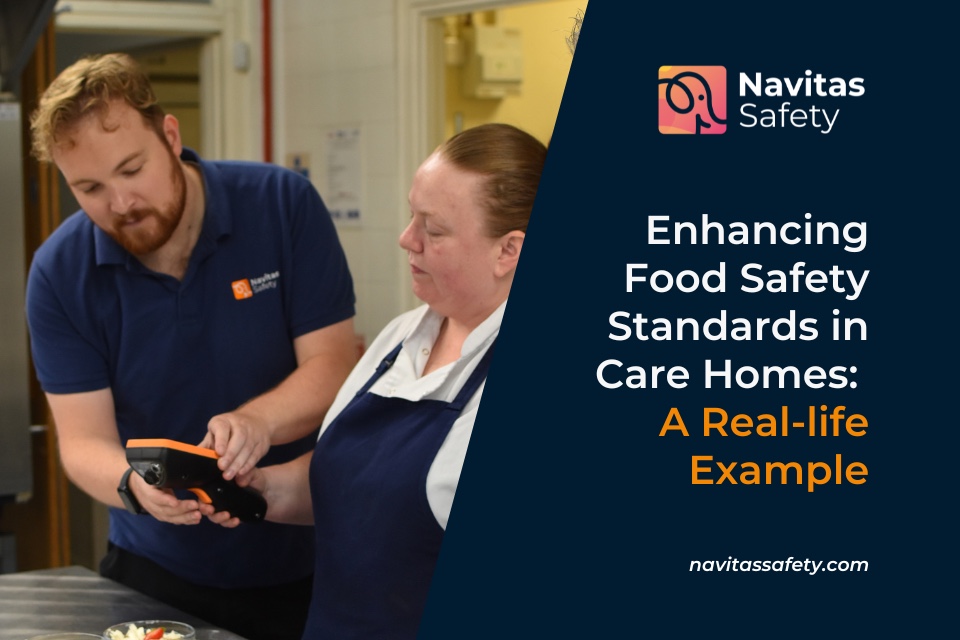In care homes, maintaining the highest level of food safety is critical for the health and well-being of residents. With stringent regulations from the Food Safety Act 1990 and oversight from the Care Quality Commission (CQC) and local authorities, care homes must stay proactive to avoid food safety violations, which can lead to reputational damage, legal consequences and risk residents’ safety.
See how one care home provider has benefited from using a digital food safety solution, saving them countless hours in managing compliance and temperature checks, allowing them to focus on providing excellent care to their residents.
Key Challenges in Care Homes
One of the primary concerns in care homes is the vulnerability of residents to foodborne illnesses, which can lead to severe health complications for elderly individuals. Common food safety risks include improper food storage, preparation, and handling. Moreover, many residents require specialised diets due to allergies, medical conditions, or cultural needs, making the role of care homes in preventing allergen exposure even more vital. Clear protocols are essential to ensure meals are prepared safely and free from cross-contamination, especially when managing allergens.
Care homes face daily operational pressures, with staff often juggling numerous tasks. Food safety checks, such as monitoring kitchen cleanliness and food storage conditions, can sometimes be deprioritised. This can result in lapses in safety, making residents vulnerable to health risks. To address these challenges, adopting a digital approach to food safety management is key.
Streamlining Food Safety with Technology
Navitas Safety offers a suite of food safety solutions that help care homes maintain compliance with regulatory standards while reducing the risk of food-related incidents.Incorporating Navitas Safety’s digital tools into daily operations can revolutionise your food safety management. You can save time by saying goodbye to paperwork and eliminate manual errors through digital checklists that allow care homes to track tasks such as food storage, cleaning routines, and temperature monitoring in real time. These tools are customisable to meet the specific requirements of each care home, ensuring tasks are completed with precision and consistency.
Digital solutions also offer real-time reporting, which can be critical during CQC and local authority inspections. They create an audit trail, making compliance easy to demonstrate, and offer an added layer of protection by reducing human error. With everything logged and verified digitally, care home managers can be confident their homes are inspection-ready.
A real-life example
Borough Care, a leading care home provider, highlights the benefits of adopting Navitas Safety’s food safety solution.
“I would highly recommend Navitas Safety’s food safety systems in any care home, it is a very easy, simple system to use, and saves me time spent going from home to home. I can see all my kitchens are maintaining their food safety compliance and it is actually saving my cooks up to 1.5 hours on a daily basis. That’s 40 hours per month per home, where we can actually utilise staff to add more value to our residents. When it comes to our EHO checks on food safety, it’s an easy system to navigate and show the inspectors what information we hold on a daily basis.”
Tony Gent, Head of Catering & Hospitality at Borough Care – See the full video case study.
The Importance of Temperature Control
Another essential aspect of food safety is temperature monitoring. Food must be stored, prepared, and served within specific temperature ranges to prevent bacterial growth. Automating temperature checks using smart sensors in refrigerators and freezers ensures that food is consistently stored at safe levels, reducing the risk of foodborne illnesses.
Manual temperature checks can be time-consuming, but automated systems streamline the process, sending alerts if temperatures deviate from safe ranges. This allows staff to respond quickly, preventing unsafe food from being served. Furthermore, automated temperature monitoring extends to medicine storage, ensuring that medications are kept at the correct temperatures to maintain their efficacy.
Empowering Staff with Ongoing Training
A robust food safety culture within care homes depends heavily on staff training. Kitchen staff and caregivers must be well-versed in food hygiene, allergen management, and the specific dietary needs of residents. Regular training sessions, supported by digital checklists and protocols, empower staff to adhere to the highest food safety standards.
Training should also include familiarising staff with the digital tools implemented within the care home. By understanding how to navigate and use these systems, staff can perform their duties more efficiently and with greater accuracy. This not only improves safety outcomes but also contributes to overall resident satisfaction.
Conclusion: A Collaborative Approach to Food Safety
Ensuring flawless food safety in care homes is a multifaceted process that requires vigilance, the right tools, and an empowered workforce. By integrating digital solutions, care homes can streamline food safety practices, ensuring compliance with regulatory standards while safeguarding the health of their residents. Navitas Safety’s Digital Food Safety offers a comprehensive solution for automating food safety management, allowing care homes to focus on what truly matters—providing excellent care.
To find out more about Navitas Safety’s solutions specifically for care homes please visit https://www.navitassafety.com/care-home-safety






